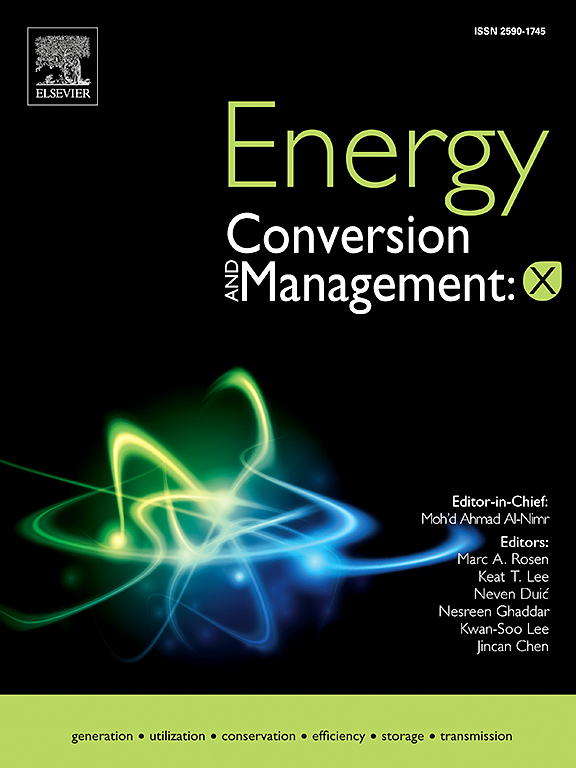Theoretical and experimental study on a self-tuning stretch-mode piezoelectric energy harvester
IF 9.9
1区 工程技术
Q1 ENERGY & FUELS
引用次数: 0
Abstract
Traditional cantilevered piezoelectric energy harvesters suffer from uneven strain and narrow bandwidth, thereby reducing harvesting efficiency. This study introduces a self-tuning stretch-mode piezoelectric energy harvester featuring a two-segment cantilevered beam that stretches a PVDF film for power generation and a sliding mass for frequency self-tuning. The harvester adapts to excitation frequencies by passively adjusting its resonant frequency through the sliding mass, governed by the interplay of inertial force and gravity. High inertial force enables the sliding mass to shift toward the beam’s free end, thereby lowering the resonant frequency, while low inertial force fails to overcome gravity, causing the sliding mass to shift toward the fixed end, raising the resonant frequency. A theoretical model is developed and validated experimentally. Frequency sweep tests demonstrate the sliding mass’s influence on frequency responses and reveal a significant hardening effect due to geometric nonlinearity. Fixed-frequency tests confirm self-tuning behavior. Under varying excitation amplitudes and frequencies, the motion of the sliding mass can be categorized into four distinct behavior regions. In the region where the frequency response exhibits two energy orbits, the movement of the sliding mass enables a transition from a low-energy to a high-energy state, thereby boosting power output. At 0.5 g excitations, the maximum voltage reaches 28.98 V—1.71 times higher than non-self-tuning stretch-mode nonlinear harvesters—with a bandwidth 1.83 times broader, demonstrating superior performance for energy harvesting applications.
自调谐拉伸型压电能量采集器的理论与实验研究
传统悬臂式压电能量采集器存在应变不均匀、带宽较窄等问题,降低了采集效率。本研究介绍了一种自调谐拉伸型压电能量采集器,其特点是采用两段悬臂梁,拉伸PVDF薄膜用于发电,滑动质量用于频率自调谐。该收割机在惯性力和重力的相互作用下,通过滑动质量被动调节其谐振频率来适应激励频率。高惯性力使滑动质量向梁的自由端移动,从而降低了谐振频率,而低惯性力无法克服重力,使滑动质量向固定端移动,从而提高了谐振频率。建立了理论模型,并进行了实验验证。频率扫描试验表明滑动质量对频率响应的影响,并揭示了由于几何非线性而产生的显著硬化效应。固定频率测试确认自调谐行为。在不同的激励幅值和频率下,滑动质量的运动可以划分为四个不同的行为区域。在频率响应表现出两个能量轨道的区域,滑动质量的运动使从低能状态过渡到高能状态,从而提高功率输出。在0.5 g激励下,最大电压达到28.98 v,比非自调谐拉伸模式非线性采集器高1.71倍,带宽宽1.83倍,在能量收集应用中表现出卓越的性能。
本文章由计算机程序翻译,如有差异,请以英文原文为准。
求助全文
约1分钟内获得全文
求助全文
来源期刊

Energy Conversion and Management
工程技术-力学
CiteScore
19.00
自引率
11.50%
发文量
1304
审稿时长
17 days
期刊介绍:
The journal Energy Conversion and Management provides a forum for publishing original contributions and comprehensive technical review articles of interdisciplinary and original research on all important energy topics.
The topics considered include energy generation, utilization, conversion, storage, transmission, conservation, management and sustainability. These topics typically involve various types of energy such as mechanical, thermal, nuclear, chemical, electromagnetic, magnetic and electric. These energy types cover all known energy resources, including renewable resources (e.g., solar, bio, hydro, wind, geothermal and ocean energy), fossil fuels and nuclear resources.
 求助内容:
求助内容: 应助结果提醒方式:
应助结果提醒方式:


